Pregnant women and babies can be vegans but careful nutrition planning is essential. Take care to ensure fibre intakes aren’t excessive during pregnancy and infancy.
Clare Collins, University of Newcastle
As more Australians opt for meat-free diets, some are cutting out animal products altogether and going vegan. But is this safe for pregnant women and babies?
It is possible to meet the specific nutrient requirements of pregnancy, breastfeeding and infancy while following a vegan diet, but there is a catch: it must be well-planned.
Researchers have developed four criteria to guide vegan food choices during the crucial life stages of pregnancy, lactation, infancy and early childhood. These four criteria will help form the nutritional foundation of a healthy vegan diet:
1) Meet your total kilojoule needs by eating large amounts and a wide variety of plant foods.
Plant food groups include grains, legumes, nuts and seeds, vegetables and fruit, with an emphasis on whole foods and those that are minimally processed.
Take care to ensure your fibre intake is not excessive during pregnancy, infancy and early childhood. Too much fibre means you will fill up before you have eaten enough food to meet all your nutrient needs.
2) Choose your vegetable fat sources and quantities carefully.
Don’t limit total fat intake during infancy. Many high-fibre vegan foods are low in kilojoules and need a lot of chewing. By including higher-fat choices you can boost the number of kilojoules in each meal or snack so infants get enough kilojoules to grow properly.
To ensure the omega-3 fats are well metabolised, consume plenty of food that are rich in omega-3 fats, such as ground chia seeds, flaxseed oil and walnuts; and fat sources high monounsaturated like olive oil.
Avoid foods rich in omega-6 fats, such as sunflower and safflower margarine and oil, and tropical fats including coconut and palm oils, as they can compete with the omega-3 fats to be metabolised. You can give omega-3s a competitive advantage by reducing the other fat types.
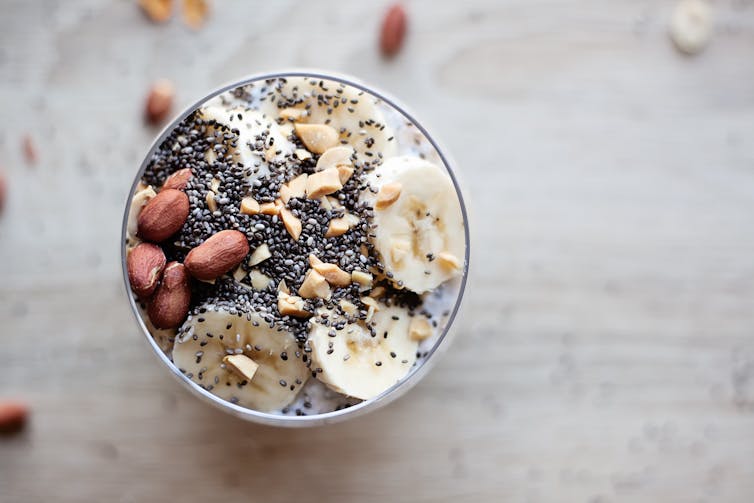
Shutterstock
3) Ensure you’re getting enough calcium and vitamin D.
Consume plant foods rich in calcium, including calcium-fortified soy and nut beverages, some breakfast cereals, tofu, nuts and seeds.
Vitamin D status depends on sun exposure and supplements rather than diet. You can download the SunSmart app to find out how much sun exposure is OK and when you do and don’t need sun protection, based on where you live.
4) Take vitamin B12 supplements and/or use foods fortified with vitamin B12.
Vitamin B12 is needed to make red blood cells, to make myelin which insulates nerves, for some neurotransmitters that help the brain function, and to make DNA.
Fortified foods include some dairy-free soy and nut milks and soy “meats”. Check the nutrition information panel on the label.
Read more:
Have you gone vegan? Keep an eye on these 4 nutrients
Vegan diets in pregnancy and lactation
Vegan and vegetarian women can be at risk of vitamin B12 and iron deficiencies during pregnancy and while breastfeeding.
A systematic review of nine studies of pregnant vegan and vegetarian women found no increase in health problems for the mothers, nor major infant malformations.
One study in vegetarian mothers reported an increased risk of male babies being born with hypospadias, an abnormality of the penis where the urethra, which is the tube that carries urine from the bladder to the tip of the penis, opens in the wrong place.
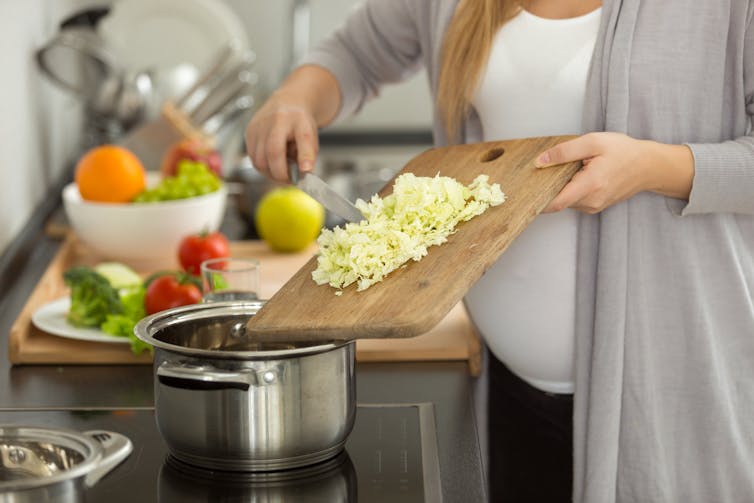
Kryzhov/Shutterstock
While some studies reported lower birth weights or higher birth weights compared with non-vegetarian mothers, many of the studies had limitations. But the review highlights the importance of optimising nutrient intakes so birthweights are in the normal range.
Vegan diets in infancy
Australia’s guidelines recommend exclusive breastfeeding for around six months and then continued breastfeeding while complementary foods are introduced, up until 12 months or for as long as the mother and infant desire.
Breastmilk, or commercial infant formula, supplies major quantities of nutrients for infants during their first year. These nutrients are needed for optimal development, especially of the brain, so deficiencies can compromise intellectual capacity.
The vitamin B12, iodine and omega-3 fat content of breastmilk depends on the mother’s intake, so mothers need to make sure they’re getting enough.
Read more:
Breastmilk alone is best for the first six months – here’s what to do next
Infants have small stomachs, which can make it difficult for them to eat the volume of plant foods needed to meet their energy requirements. Lowering the fibre intake can help. You can do this by using refined or lower-fibre versions of grains, peeling some beans and legumes, cooking well and pushing them through a sieve.
Regularly measuring the baby’s length and weight and plotting on infant growth charts is the best way to monitor growth.
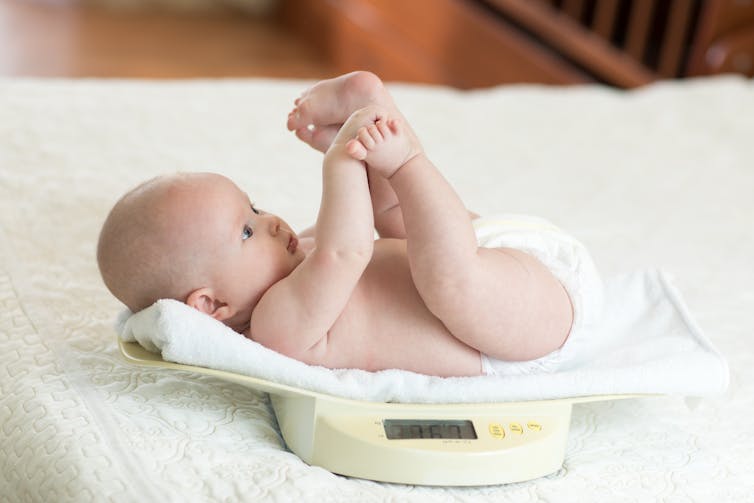
Oksana Kuzmina/Shutterstock
Ensure foods are offered in forms that don’t pose a choking hazard, for example nut butters but not nuts.
Having different sources of plant proteins – including legumes, dried beans, grains, nut and seed butter and oils – helps meet needs for specific amino acids, which are the building blocks of protein.
Sources of iron include iron-fortified infant cereals, mashed and peeled cooked (from dried) beans and legumes. Consuming vegetables, fruit or juice rich in vitamin C with meals helps convert plant sources of iron and zinc into the form that can be absorbed.
Read more:
Why iron is such an important part of your diet
Putting it all together
While some vitamin and mineral supplements may be needed to optimise micronutrient and omega-3 fat intakes, how can this information be translated into actual meals?
Check out these menus adapted from the VegPlate.
Pregnancy sample menu
For pregnancy, a sample day’s menu could look like this:
Breakfast
¼ cup calcium fortified soy yoghurt with 1 cup (60g) mixed grain cereal, 25 raisins (15g) and 14 almonds (15g).
Mid-meal
One apple plus a tablespoon of sesame butter.
Lunch
½ cup cooked quinoa with 1 small can kidney beans, 1 cup (100g) red capsicum, 100g baby spinach, 8-10 walnuts (30g), 2 dried figs (30g), with balsamic dressing + 1 tsp olive oil, coriander and 2 slices wholemeal bread (60g).
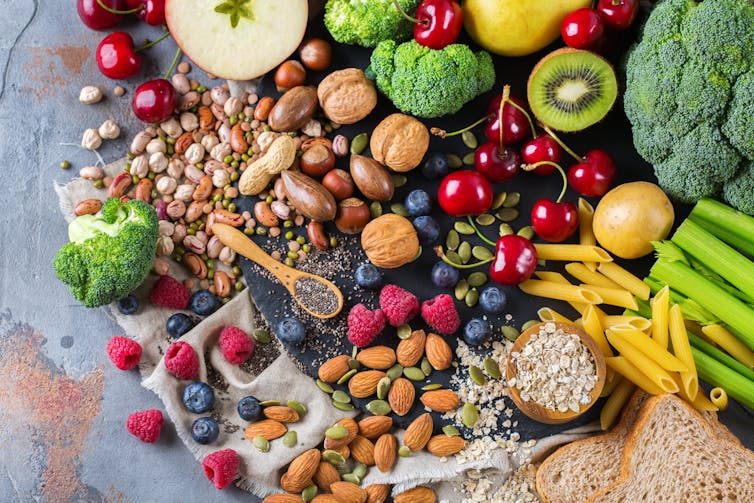
Antonina Vlasova/Shutterstock
Mid-meal
3-4 cups home popped popcorn (30g) with added nutritional yeast, with a juice made with 1/3 cup orange juice and ½ cup celery, kale and carrot juice.
Dinner
200g pumpkin and ½ cup cooked chickpeas stir fried or made into soup,
with 1/3 cup (60g) cooked buckwheat, 1.5 tablespoons sunflower seeds (15g), 5g flaxseed oil, 80g roasted tempeh, 100g broccoli and 5g olive oil and 1-2 slices of wholemeal bread (45g).
Supper
10 Cashews (15g).
Queensland Health also has a factsheet for vegan and vegetarian pregnant women.
Read more:
Five ways to boost your nutrition before pregnancy
Infant sample menu
For infants, a sample day’s menu for a nine-month-old who does not have any nut allergies could look like this: (Note: this assumes the infant’s mother has adequate nutritional status and dietary intake.)
Breakfast
2 tablespoon (10g dry) iron fortified infant cereal mixed with calcium fortified soy yoghurt or infant formula, plus a breastfeed.
Mid-meal
½ medium pureed banana (80g) plus 2 tsp almond butter (10g), plus a breastfeed.
Lunch
½ cup cooked white/refined rice (25g dry weight) well-cooked in unsalted vegetable stock with 2 dessert spoons (15g dry weight) hulled red lentils plus 1 tablespoon strained pumpkin, 2 tsp tahini (10g), 1 tsp olive oil (5g) and 1 tsp flaxseed oil (5g).
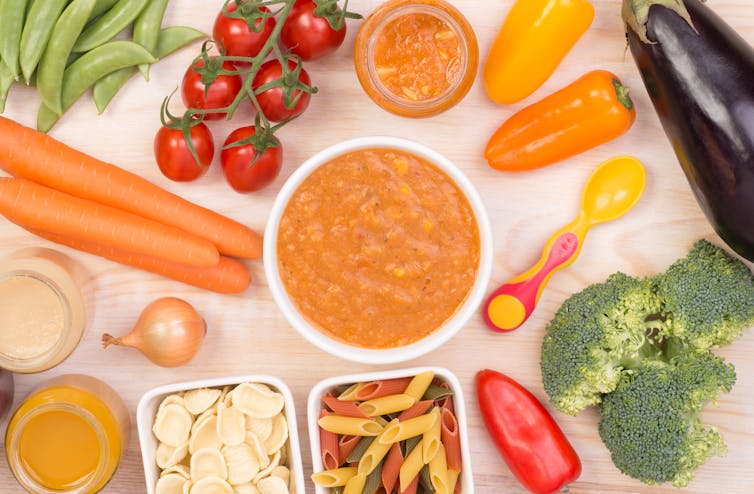
Photka/Shutterstock
Mid-meal
⅓ cup calcium fortified soy yoghurt plus 1 tablespoon pureed apple and a breastfeed.
Dinner
25g dry iron-fortified infant pasta (½ cup cooked) cooked in unsalted
vegetable stock with 1 tablespoon of tomato puree or pasta sauce, 2 dessert spoons (15g dry weight) split peas, 2 tsp cashew butter (10g), 1 tsp olive oil (5g) and 1 tsp flaxseed oil (5g).
Supper
Breastfeed.
More guidance is available at VegPlate Junior.
Read more:
Why vegan diets for babies come with significant risks
Keep in mind that nutrient deficiencies can occur if vegan diets aren’t carefully planned.
If a full nutrient analysis of your usual dietary patterns is needed, an accredited practising dietitian could assist, along with providing strategies to optimise nutrient intakes.
Your GP can advise on the need for blood tests to monitor nutrients such as iron and vitamin B12.![]()
Clare Collins, Professor in Nutrition and Dietetics, University of Newcastle
This article is republished from The Conversation under a Creative Commons license. Read the original article.






















-

-
-
serotonin said
- 09 Jun 2019
Reply
-

-
-
mom81879 said
- 21 May 2019
-

-
-
becstalou said
- 15 May 2019
-

-
-
DaffyD said
- 04 May 2019
-

-
-
rnash02 said
- 04 May 2019
-

-
-
BellaB said
- 03 May 2019
Post a comment9:45 am
9:14 pm
4:44 pm
10:31 am
8:24 am
7:24 pm
To post a review/comment please join us or login so we can allocate your points.